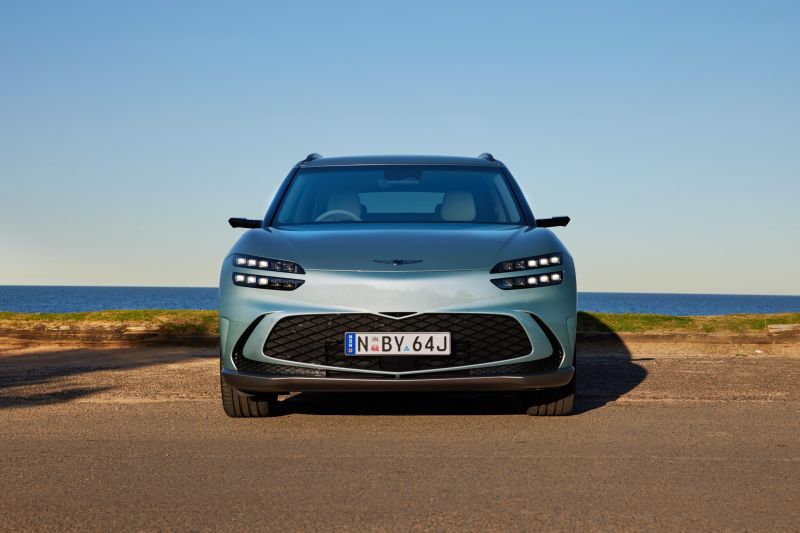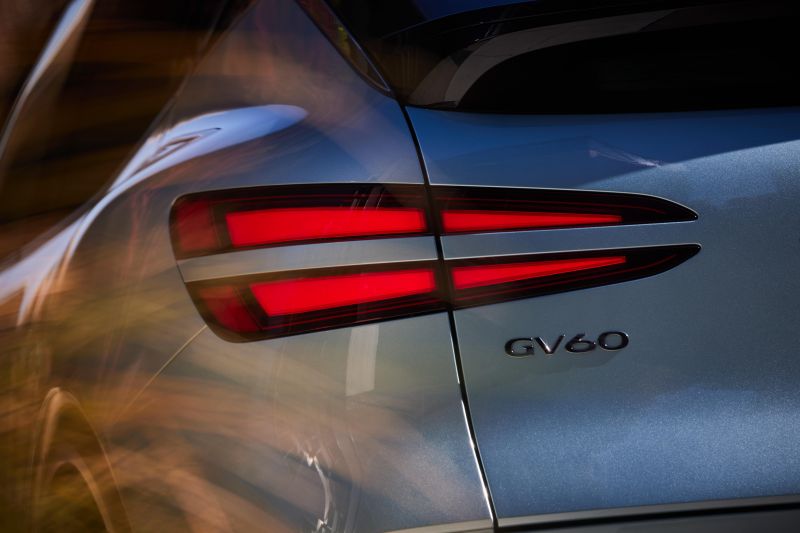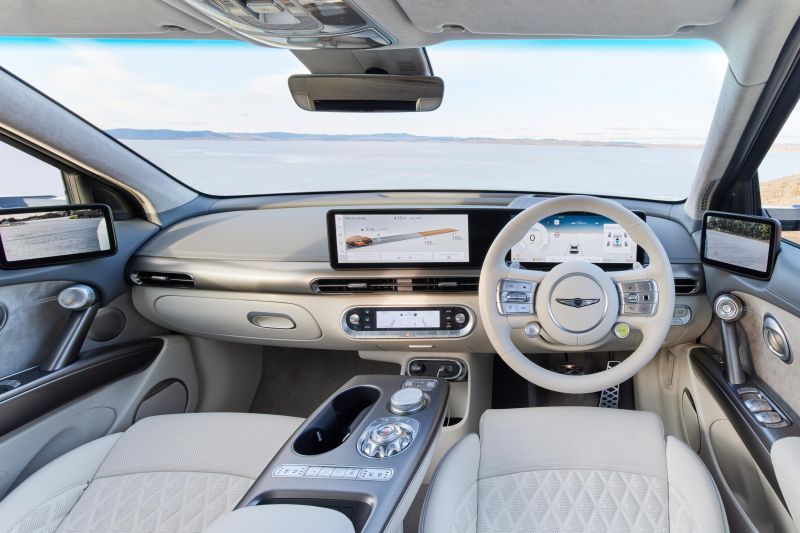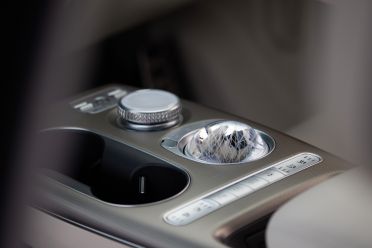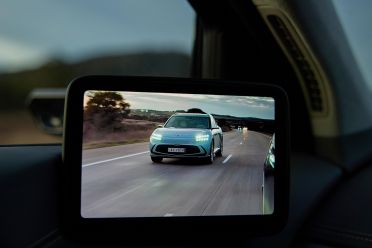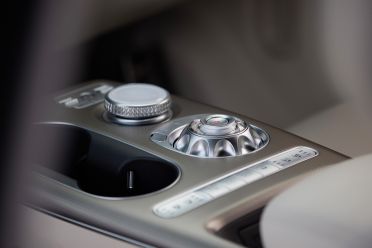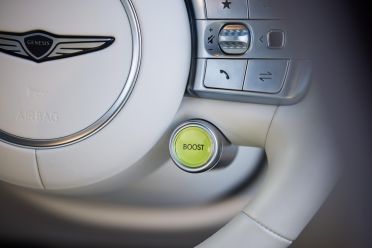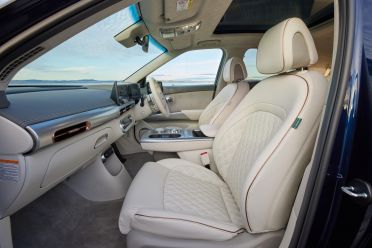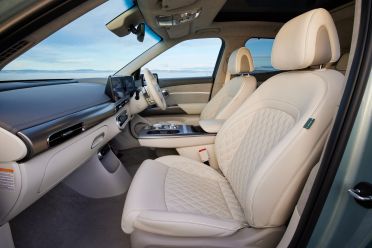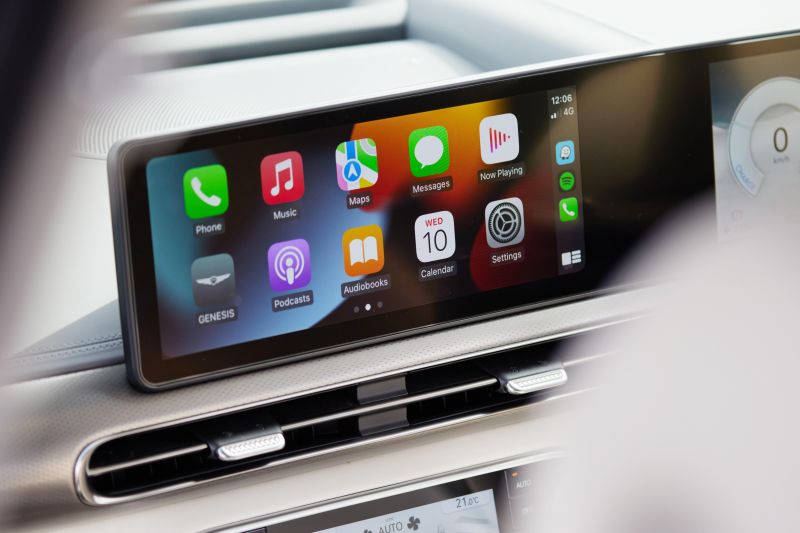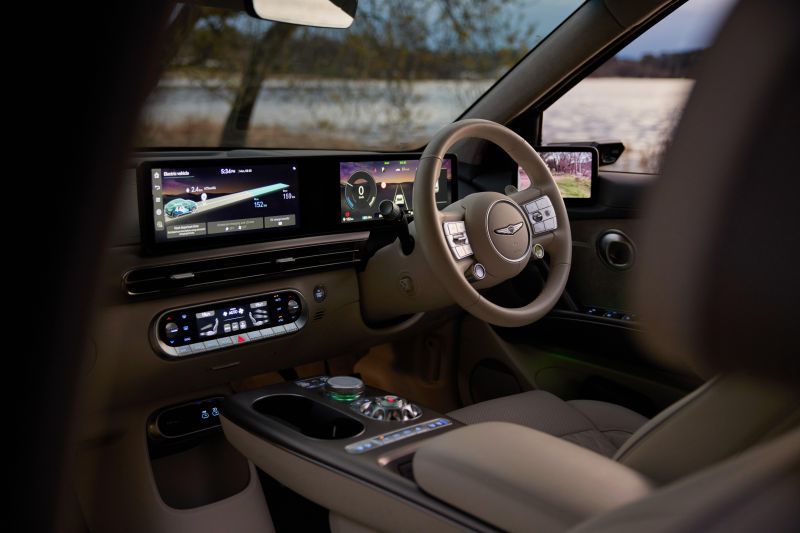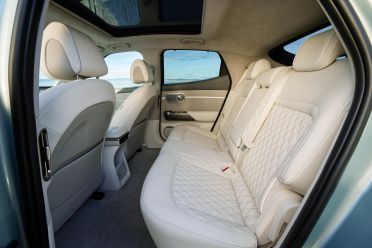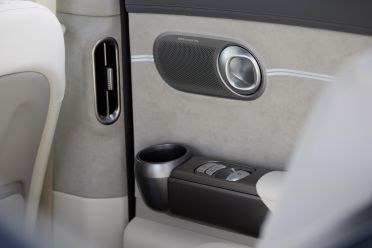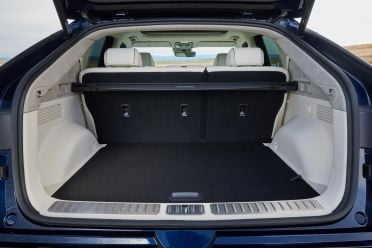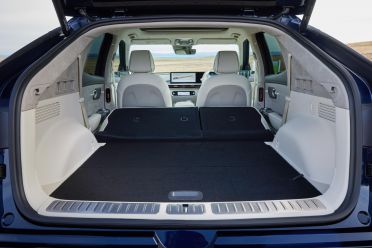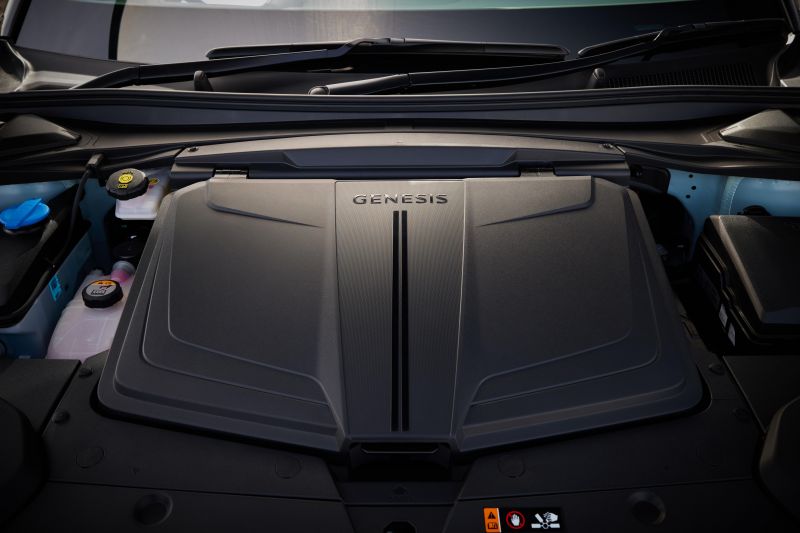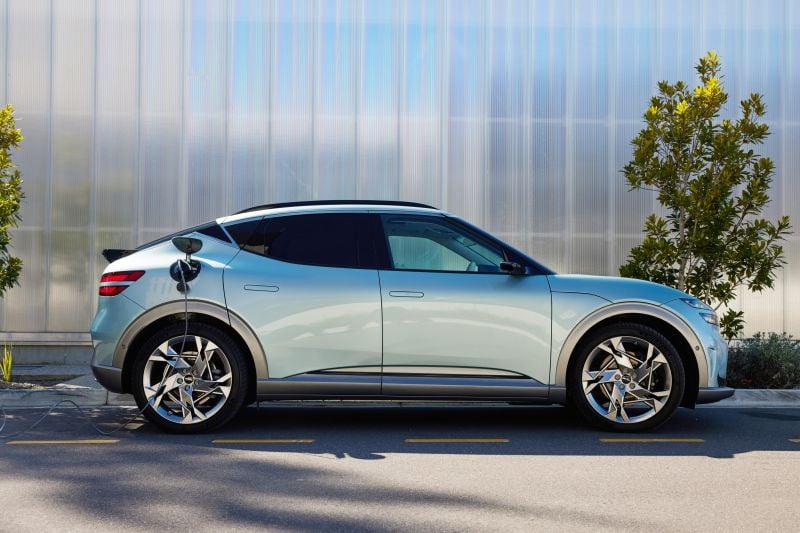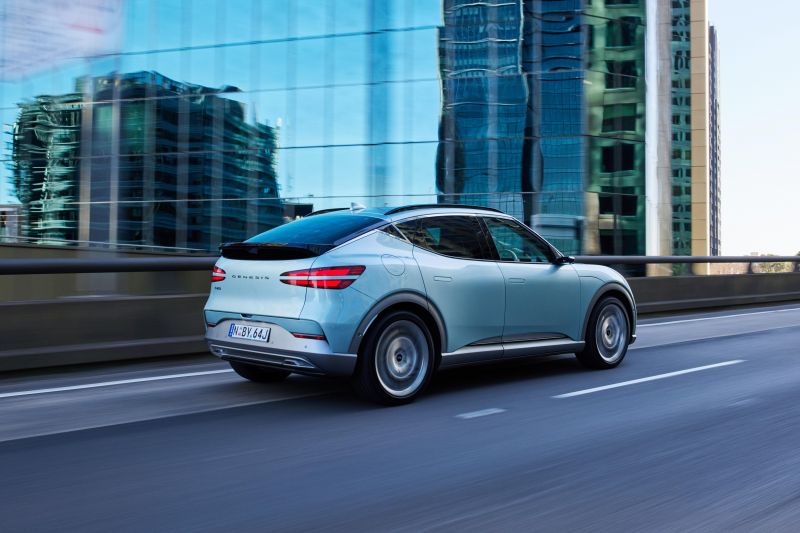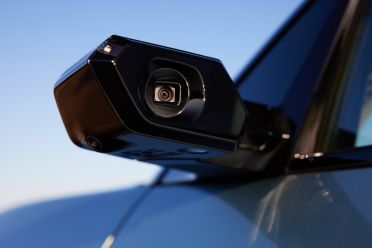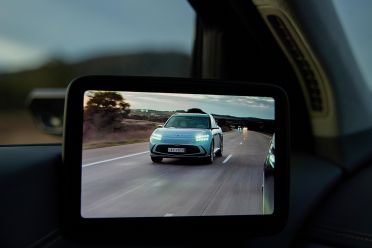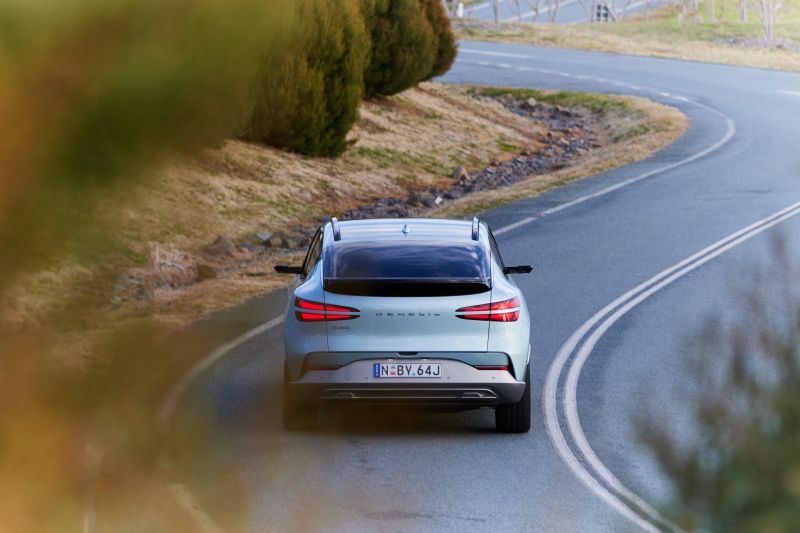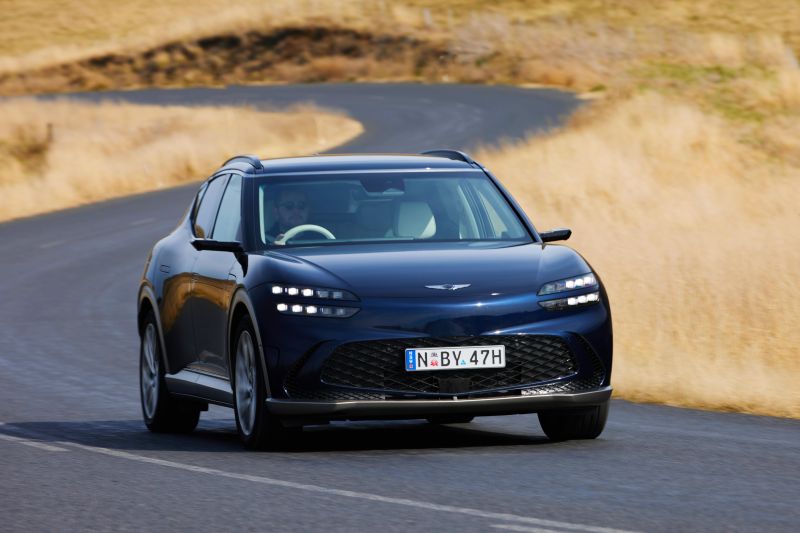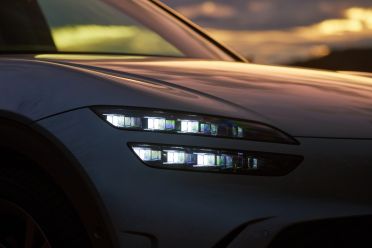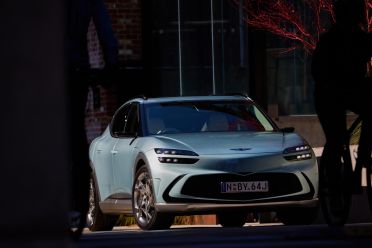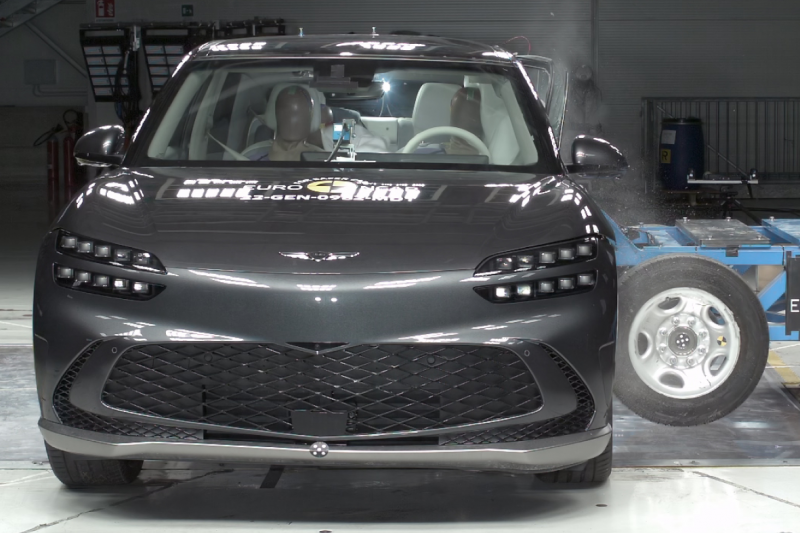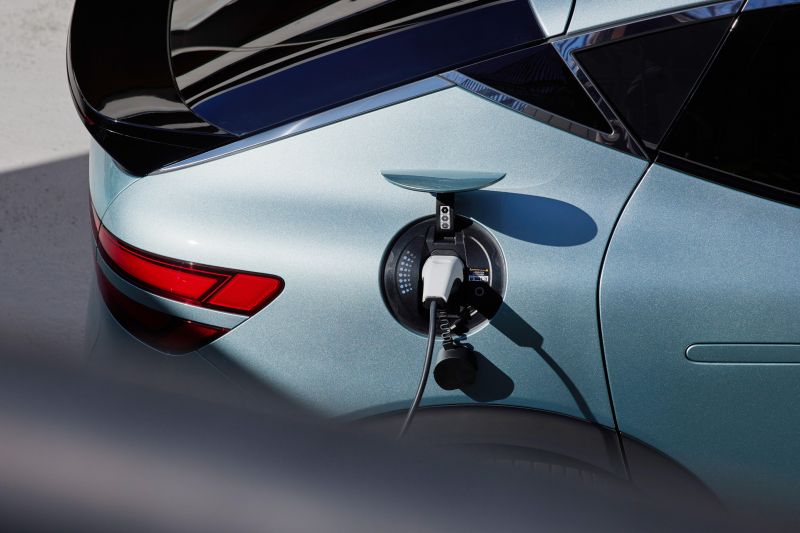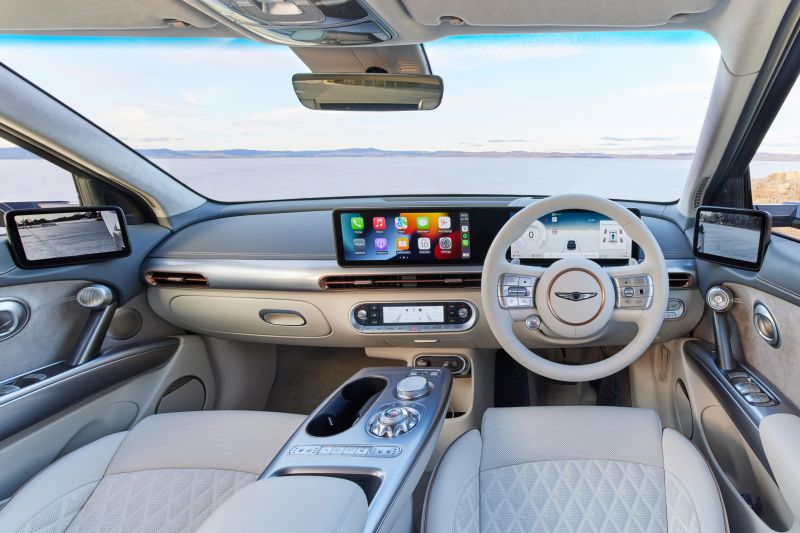Genesis is finally releasing its first vehicle based on the Hyundai Group’s all-electric E-GMP platform – the GV60.
A more luxurious sibling to the Hyundai Ioniq 5 and Kia EV6, the 2023 Genesis GV60 lands in Australia exclusively with dual-motor all-wheel drivetrains, led by a high-spec Performance variant that will be the most powerful vehicle on the platform until the EV6 GT and Ioniq 5 N arrive.
Compared to Electrified versions of existing combustion cars – Electrified GV70 and G80 – the GV60 is pitched as a more compact, dynamic EV. That’s despite the GV60 and GV70 both being classed as premium mid-size SUVs by VFACTS.
The brand itself says it believes the GV60 will attract the early adopters of EVs who want to stand out, and embrace the vehicle’s quirky design and dedicated architecture.
It’s also expected to bring customers from brands beyond the Hyundai Group stable, particularly those facing crippling supply shortages.
We attended the Australian media launch in Melbourne to see if it’s any good.

How much does the Genesis GV60 cost?
The Australian GV60 range kicks off at $103,700 before on-road costs, extending to $110,700 before on-roads for the flagship Performance AWD model.
It’s steep compared to an equivalent EV6 or Ioniq 5 – between $15,000 and $25,000 more expensive – but Aussie GV60s come standard with the Luxury Package, usually a circa $10,000 option on Genesis products, and we currently don’t get the more affordable single-motor version Down Under (though it’s been homologated).
If you change lenses though, the GV60’s positioning isn’t half bad. The smaller and less powerful Mercedes-Benz EQA 350 4Matic is $2900 cheaper when optioned with the Edition 1 package ($100,800), while mid-size luxury SUVs at this price point are usually plug-in hybrids as opposed to EVs.
You can’t talk EVs without mentioning Tesla, and the Model Y Performance is quite a bit more affordable at $96,700 before on-roads – though whether you consider Tesla ‘premium’ enough is up to you.
2023 Genesis GV60 pricing:
- Genesis GV60 AWD: $103,700
- Genesis GV60 Performance AWD: $110,700
Key rivals include:
- BMW iX3: $114,900
- Hyundai Ioniq 5 Dynamiq AWD: $77,500
- Kia EV6 GT-Line AWD: $87,590
- Mercedes-Benz EQA 350 4Matic: $96,900
- Mercedes-Benz EQB 350 4Matic: $106,700
- Tesla Model Y Performance: $96,700
- Volvo C40 Recharge Twin: $82,490
All prices exclude on-road costs
What is the Genesis GV60 like on the inside?
How the interior looks and feels can be quite dependent on how you spec it.
Pictured is the light and airy Glacier White quilted Nappa leather with Monstera Green upper sections and cooper trim accents in the GV60 AWD, which almost has a Tiffany & Co blue vibe to it.
Obsidian Black main hide is available on the AWD, as is the same Glacier White but with less ostentatious Ash Grey upper accents. The GV60 Performance AWD is also available with Torrent Navy perforated Nappa leather and eye-popping lime stitching and piping.
Regardless of the finish you choose, the GV60’s cabin in standard Luxury Package-spec in Australia looks and feels a cut above what you get in its mainstream-badged platform mates.
There’s high-resolution displays everywhere. On top of the standard dual 12.3-inch widescreen array for the instrument cluster and infotainment systems, there’s additional displays on the doors which stand in for conventional mirrors.
We’ll get to how the digital side mirrors function a bit later in the driving section, but safe to say they’re more user-friendly than then optional units in the Audi e-tron.
I love the suede headliner, which really adds a touch of class to the GV60’s cabin. A standard power panoramic sunroof lets plenty of light in, adding to the perceived spaciousness of the interior.
An additional party trick is the Crystal Sphere drive selector, which when the vehicle is off looks like a crystal ball and lights up with the chosen ambient lighting colour, then rotates to reveal a shift-by-wire rotary gear selector that offers haptic feedback when you switch into reverse.
The front seats are comfortable and supportive, and offer 18-way power adjustment for the driver and 12-way power adjustment for the passenger. Drivers get additional cushion length and bolstering adjustment compared to the front passenger.
There’s two-position memory for the driver too and a power-adjustable steering column – the memory presets encompass seat, mirror and steering wheel settings. Additionally, the front pews are heated and ventilated while the steering wheel offers heating.
Both front seats also offer a Relaxation Mode function, which reclines them like armchairs for when you’re waiting for the vehicle to charge, for example.
Most of this stuff is available on the Ioniq 5 and EV6 in fairness, such as the memory seats and Relaxation Mode (with different naming, naturally), but the Genesis version really does seem to have more bases covered.
The lovely 12.3-inch twin displays are a little confusing at first, as Genesis has employed a new skin over the Hyundai interface which changes things up a bit, but in typical fashion it’s bright, crisp and snappy.
My favourite feature was the augmented reality (AR) navigation function, which uses the front-facing camera to project graphics and animations on the video feed to show you where you need to go – you can put it in the instrument cluster, too.
It’s a feature we’ve seen from Mercedes-Benz, but the Genesis version is certainly competitive. Having it in the cluster between the virtual dials made it feel like a video game, which was pretty cool.
In a first for the Genesis brand, the GV60 comes standard in Australia with a 17-speaker Bang and Olufsen premium sound system. We didn’t get a chance to really test it out during our relatively short launch drive, but given our past experience with high-end Hyundai and Genesis audio systems, we have no doubt it’ll be suitably punchy.
With that said, it’s disappointing Genesis still doesn’t offer wireless smartphone mirroring, or connected app services despite Hyundai and Kia starting to roll out net-based functions on its new launches. Some parts of the infotainment still have obvious links to its mainstream parent too, such as the navigation mapping.
Genesis has gone some way to differentiate the driver’s experience, with a completely new steering wheel and multifunction control design, and added features in the digital instrument cluster.
In addition to the aforementioned AR navigation display, drivers can select from a couple of cluster layouts including a pair of virtual dials for the power meter and speedometer, the latter not available on the Ioniq 5 and EV6. I like the virtual dials with configurable central real estate – it finally offers a map view, too.
The Hyundai Group’s innovative Blind Spot Monitor complements the Digital Side Mirrors by projecting a camera feed into the instrument cluster when you indicate on either side. It’s still one of the better systems of its type, eclipsing the likes of Honda’s LaneWatch camera tech.
Complementing all this is a 12.0-inch colour head-up display, which shows turn-by-turn navigation prompts (on top of the AR stuff already mentioned), map-based traffic sign data, a speedometer, safety systems, cruise control settings, warning lights, and even radio/media information.
Despite the sloping roofline, the Genesis GV60 offers good second-row space with the standard panoramic sunroof.
At 6’1 I can fit behind my own driving position with good leg and knee room, and the scalloped rear head section meant I wasn’t wedged against the headliner. That said, there wasn’t a whole lot of breathing room above my voluminous locks.
While second-row passengers don’t get a third zone of automatic climate control, there are pillar-mounted directional air vents as well as floor-mounted units that ventilate the rear. For cold days, the outboard rear seat backs and bases offer heating.
Additional rear amenities include map pockets behind the front seats, cup holders in the doors, a fold-down centre armrest with additional cupholders, a storage net at the rear of the centre console, as well as ISOFIX and top-tether anchors for the kiddies.
The rear of the GV60 also offers a V2L outlet underneath the centre seat, meaning you can plug in a laptop charger or appliance via the three-pin domestic socket.
Behind the second row, the GV60’s sloping tailgate eats into cargo volume somewhat, particularly compared to its platform mates.
Genesis quotes 432 litres with the rear seats in place, expanding to 1460 litres when folded. For reference, the Hyundai Ioniq 5 quotes 527L/1587L, and the Kia EV6 offers 480-390L/1260-1280L.
Additionally, there’s a small compartment under the bonnet which measures around 25 litres. Single-motor versions of E-GMP vehicles get a larger ‘frunk’ as there’s no space-eating front motor, though none come close to Tesla’s front cargo area.
No GV60 gets a spare tyre of any kind, instead a tyre repair kit is standard across the range.
What’s under the bonnet?
The GV60 AWD runs the same 234kW/605Nm dual-motor electric drivetrain as AWD versions of the Ioniq 5 and EV6, with the front motor quoting a 74kW output and the rear 160kW.
Genesis claims a 0-100 time of 5.5 seconds, and a WLTP combined driving range of 470 kilometres – all variants run a 77.4kWh lithium-ion battery. Combined energy consumption is a quoted 18.8kWh/100km.
Meanwhile, the GV60 Performance AWD ups that to 180kW e-motors on each axle, quoting system outputs of up to 360kW and 700Nm when in Boost Mode. In normal driving, the GV60 Performance generates 320kW and 605Nm.
The Performance quotes a 0-100 time of 4.0 seconds in Boost Mode, and a driving range of up to 466 kilometres. Energy consumption for the GV60 Performance is rated at 19.1kWh/100km.
Given the two variants share the same battery and the same 800V architecture, they’re capable of charging at up to 350kW when hooked up to a DC public fast charger, meaning the GV60 can go from 10 to 80 per cent in 18 minutes.
However, it’s well documented that E-GMP products rarely hit the quoted 350kW peak in the real-world, rather sitting around the 230kW mark. Genesis says it’s down to temperature management to avoid the battery overheating, though maintains the “up to 350kW” claim is accurate.
The GV60 also features V2L technology, which allows owners to plug appliances into the car and run them on a 3.6kW power supply – the same technology features on the EV6 and Ioniq 5.
Unlike its Hyundai and Kia siblings, however, Genesis says the GV60 is able to pre-condition its battery for more efficient fast charging at DC stations.
Given our limited time behind the wheel, it’s hard to gauge just how accurate the company’s range and energy consumption claims are. With that said, both models were showing an indicated readout just over 20kWh/100km during our drive loops, which included some more spirited and hilly sections.
How does the Genesis GV60 drive?
Our launch drive in the GV60 started from Melbourne’s CBD and took us out to the Yarra Valley.
With grey, wet conditions, it was a good opportunity to test out various tech features in the GV60’s arsenal, as well as seeing how both dual-motor drivetrains handled poor weather; in terms of getting power down as well as dynamics.
The bulk of our time was spent in the GV60 Performance AWD, which when setting off from the CBD felt very relaxed.
Unlike the base model, which runs a ‘high performance damper’ setup with no adaptive settings, the Performance AWD runs the brand’s Preview-ECS – or Road Preview-Electronically Controlled Suspension – which uses the front-facing camera and adaptive dampers to vary the ride and damper settings on the fly, based on road conditions.
Considering the GV60 Performance AWD is running big 21-inch alloys shod in 255/40 Michelin Pilot Sport EV rubber, ride comfort is surprisingly well-sorted – if a little busy over high-frequency imperfections you normally find on inner-city roads.
Genesis hasn’t done a full local suspension tune on the GV60, though a locally-based team selected various settings from a global catalogue of tunes to create the setup fitted to Australian-bound models.
Wafting around the CBD was a pleasant experience in the GV60 Performance, with a well-insulated cabin, decent outward visibility and linear acceleration making daily driving-style commutes a doddle. We had the native navigation with AR prompts running in the instrument cluster, and while there was a lot going on at first, it became quite handy.
For those not used to driving in Melbourne’s CBD, with its many lanes and hook turns, having the animated graphics literally showing you where to go on the road ahead was quite helpful – I’m good with hook turns, but if you aren’t the GV60 can help you navigate the city.
The steering feels light and accurate in its regular Comfort mode, making it easy to pilot through traffic-filled, tight city streets. It firms up in Sport – more on that in a bit.
We mentioned the Digital Side Mirrors earlier, and it was here in the confines of Melbourne’s CBD where they had time to shine.
Audi’s e-tron camera-based mirrors, for example, are a quite limited in viewing angle and lack ease of use in adjustment, but surprisingly the Genesis’s units were much easier to live with.
The large displays are well placed in terms of the driver’s line of sight, and there’s a nice wide field of view. Genesis has also implemented line markings to show how far away following vehicles on each side are, and there’s the added assistance from the Blind Spot View Monitor to make you very aware of any cars in your blind spot.
It takes some adjustment no doubt, but within a bit of wheel time I got used to them fine. Best to take a GV60 for a test drive and try them for yourself to get the final verdict.
We took Melbourne’s Eastern Freeway (M3) as we left the city and headed for the Yarra Valley, and quickly we noticed the GV60 is a pretty capable zero-emissions GT.
At 100km/h on reasonable-quality tarmac, the Genesis’s cabin was nicely hushed if with a little bit of roar from those low-profile performance tyres, though it’s otherwise a serene and comfortable place to spend longer stints.
It was a similar story on some winding B-roads as we headed past the suburbs, into Kinglake and on to Yarra Glen. The GV60 loves high-speed, sweeping roads where it can stretch its legs and settle its ride.
There were some tighter, more technical sections that we encountered at the same time heavier rain hit. For me, this 360kW crossover felt quite heavy – it is 2210kg in Performance spec, after all – and didn’t really give me the confidence to really push it through some tight sections on the way to Kinglake.
Once the roads widened up and the speed increased, however, the GV60 impressed with strong acceleration out of bends, good grip from the AWD system and chunky rubber, and accurate handling. The Performance also gets an electronically-controlled mechanical limited-slip differential at the rear to shuffle torque to the wheel with most grip.
The lower-grade GV60 AWD showed similar attributes on a shorter drive on the high-speed B-roads surrounding the Zonzo Estate winery just outside Yarra Glen, our lunch stop during our day of driving.
Despite having passively damped suspension and less power, as well as no e-LSD on the rear axle, the GV60 AWD is more than quick enough for most people, and handled with accuracy and confidence – albeit in drier weather.
The smaller 20-inch wheels and 255/45 Michelin Pilot Sport EV rubber seemed to be a little quieter on rougher sections of tarmac compared to the Performance, though that could be down to less water noise.
In both models, the slim Digital Side Mirrors help to cut out wind noise, too.
In terms of the wider driver assistance suite, the GV60 has everything you need to take the load off a longer trip.
On top of the aforementioned Digital Side Mirrors and Blind Spot View Monitor systems, there’s excellent adaptive cruise control and Lane Following Assist (centring) which essentially allows for semi-autonomous driving on the highway.
Rear cross-traffic assist means the car will brake for you if it senses an oncoming vehicle in your path, while front and rear parking sensors combined with surround-view cameras with 3D view mean there’s no excuse for car park bingles or scraped wheels.
Driving in poor weather or low light will be easier with the GV60’s swish Matrix LED headlights with adaptive high-beam, too – adaptive high-beam or Matrix LED tech isn’t offered on the EV6 or Ioniq 5 locally.
What do you get?
GV60 AWD highlights:
- 20-inch alloy wheels
- Michelin Pilot Sport EV tyres (255/45 R20)
- Silver monobloc front brakes
- Front, rear ventilated brake discs
- Variable Gear Ratio steering
- Flush powered door handles
- Matrix LED headlights
- Intelligent High Beam
- Vision glass roof (fixed)
- Puddle lights with Genesis logo
- Roof rails
- Rain-sensing wipers
- Acoustic laminated windshield, windows
- Rear privacy glass
- Active Air Flap
- Nappa leather-appointed seats, quilted
- Leather-appointed dash, door trim, console
- Suede headliner
- Adjustable ambient lighting
- Aluminium garnishes and copper accents
- Dual-zone climate control
- Rear air vents
- Heat pump
- V2L exterior, interior
- Digital Side Mirrors
- Fingerprint authentication system
- Head-up display
- 12.3-inch digital instrment cluster
- 12.3-inch touchscreen infotainment system
- Satellite navigation with augmented reality (AR)
- Live traffic information
- Apple CarPlay, Android Auto (wired)
- Digital radio
- Integrated controller incl. handwriting recognition
- 17-speaker Bang & Olufsen premium audio
- Active Noise Control – Road (noise cancelling)
- e-Active Sound Design (engine noises)
- Wireless smartphone charger
- 18-way power driver’s seat incl. memory
- 12-way power front passenger seat
- Ergo Motion massage function for driver
- Easy Access, Relaxation Mode seat functions
- Heated, ventilated front seats
- Heated steering wheel
- Heated 2nd row seats (outboard)
- Power tilt/telescopic steering wheel
- 60:40-split rear seats
- Power tailgate with hands-free opening
- Rear door manual sunshades
- 3 x USB-C charge ports
GV60 Performance AWD adds:
- 21-inch alloy wheels
- Michelin Pilot Sport EV tyres (255/40 R21)
- Rear limited-slip differential (e-LSD)
- Road-Preview Electronic Control Suspension
- Boost Mode (360kW/700Nm)
- Black monobloc front brakes
- Alloy pedals
- Metallic interior accents
Is the Genesis GV60 safe?
The GV60 was recently awarded a five-star ANCAP safety rating, off the back of Euro NCAP tests.
Category scores included an adult occupant protection rating of 89 per cent, a child occupant protection rating of 89 per cent, a vulnerable road user protection rating of 63 per cent, and a safety assist rating of 88 per cent.
ANCAP praised the GV60’s performance in crash testing, awarding it full marks for protection of the front-seat passenger in the frontal offset test, the driver in the side impact test, and for child occupants in frontal and side-impact crashes.
It dinged the GV60, however, for its protection of pedestrians in a collision, though noted it was still within the threshold for five stars.
Standard safety features include:
- Eight airbags incl. front-centre airbag
- Autonomous emergency braking (AEB)
- Pedestrian, Cyclist detection
- Junction assist
- Blind-spot assist
- Blind Spot View Monitor (cameras)
- Rear cross traffic alert and assist
- Driver-attention monitoring
- Lane departure warning
- Lane Following Assist (centring)
- Lane keep assist
- Front and rear parking sensors
- Surround-view cameras incl. 3D view
- Safe Exit Assist
How much does the Genesis GV60 cost to run?
The GV60 is backed by a five-year, unlimited-kilometre warranty, as well as an eight-year warranty on the high-voltage EV battery.
It also comes with a range of owner benefits designed to win potential buyers over to the Genesis way of life.
Five years of scheduled maintenance maintenance is free, and Genesis will collect your car when it’s time for a service and leave a service loan vehicle for the same period.
There’s also 10 years of free roadside assist and satellite navigation map updates, and buyers of Genesis Electrified products also get the choice of a five-year subscription to the Chargefox network, or a complementary home AC charger including installation.
CarExpert’s Take on the Genesis GV60
Polarising looks aside, the Genesis GV60 does present a luxurious mid-way point between semi-premium EVs and proper premium-badged competition.
Yes, there are some obvious links to its Hyundai parent, but the swathes of Nappa leather, rich catalogue of tech and convenience features, as well as the refined, effortless drive experience are all highlights.
Add to that a long warranty, a near-impeccable ownership benefits program and the choice of a complementary home charger or five-year Chargefox subscription, and the switch to EV has never been so easy.
The $103,000 starting price also doesn’t seem too bad when you compare the GV60 to non-Tesla competition, though the Tesla Model Y Performance is extremely good value – money for metal – in comparison to not just the Genesis but the wider segment.
Negatives? The back seats and boot aren’t as commodious as a vehicle this size could be, it feels its 2.0t-plus weight in tighter bends, and some of the cool tech features may have a learning curve.
It’s also a shame the single-motor RWD version isn’t currently available Down Under, which would likely dip the starting price below the $100,000 barrier and also offer a driving range over 500 kilometres.
All told however, the GV60 is yet another well-rounded offering in the premium EV space, and you might have a better chance of getting one sooner compared to rival brands if you get in quick – read more about GV60 supply here.
Click the images for the full gallery
MORE: Everything Genesis GV60






